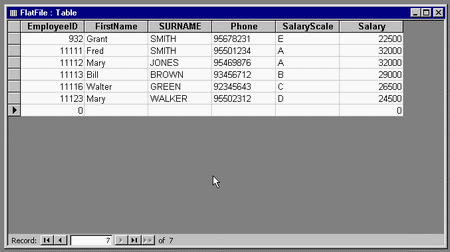20
2012
What is a Flat File Database?
Databases have evolved as technology continues to develop. Contrary to popular belief, databases have existed before computers were built. The data was not recorded in a computer but with crude accounting systems which were used by banks. There are different ways to collect and organize data to form a database. One of the models used in early time before the age of computers were flat file databases. A flat file database encodes a table of data in different means as a plain text file. A list of name, phone numbers, and addresses written by hand in table can be considered as a flat file database. To put it simply, any data which is placed in a single file in the form of columns and rows is a flat file database. This database evolved and led to more complex systems as computers emerged in the market.
Flat File Database
Flat files are plain texts which contains one record per line. The record has a single field that is separated by a comma or limited to a fixed length. Flat file databases were used by early computer machines. These machines implemented simple databases. Herman Hollerith was the first one to use the concept of a flat file database with the use of punch cards. His idea consisted of a string of 80 digits and letters, which represented the residents of the U.S., which were padded with spaces. He sold his idea to the US Census which used his machines and his punched cards to store data. This became the first computerized data which composed of boxes of punched cards. In the following years, computers used flat file databases for accounting purposes, particularly payroll. These computers were used by the military and corporations. The demand for these machines led to the creation of relational databases which used normalized tables to organize data. The early applications still used Hollerith cards, and the enterprise grew into a company called IBM. In the 1980s, flat file databases were used by DOS and Macintosh. These programs were designed to enable individuals to make their own databases. They were in the same level with spreadsheets and word processors that were popular at that time. Early versions included FileMaker and shareware PC-File.

Flat File Database Applications
Flat file databases are used today with or without the use of computers. The term is defined broadly if used for general purposes but becomes narrowed in conjunction with the database theory. Although there are a few programs left that will enable novice programmers to create their own flat file database, there are still many computer applications who use it. There are applications that enable users to store and retrieve their data from flat files with a predefined set of fields. Examples of these are programs that allow you to manage appointments or manage your collection of books. An organizer or planner can be considered as a flat file database. By simply listing your contacts along with their personal information which you will then use a reference can be considered as a flat file database. The application of flat file databases can range from simple handwritten records to an enterprise-level solution.
Further readings
Advertisements
Recent Posts
- What is a Disaster Recovery Data Center
- What is a Relational Database?
- What is a Flat File Database?
- What is a DSN or Database Source Name?
- What is a Disaster Recovery Plan?
- What is an Open Source Database?
- What is Disaster Recovery?
- What is a Database Cluster?
- What are Database Servers?
- What are Database Forms?
Random Posts
- What is a BLOB or Binary Large Object?
- What is a Sybase Database?
- What is Database Auditing?
- What is an Open Source Database?
- Remote DBA or Database Administration Services
- What is Database Normalization?
- What is Database Hosting?
- What is a DSN or Database Source Name?
- What is an Oracle Database?
- What is Datawarehouse?

 An article by
An article by 




